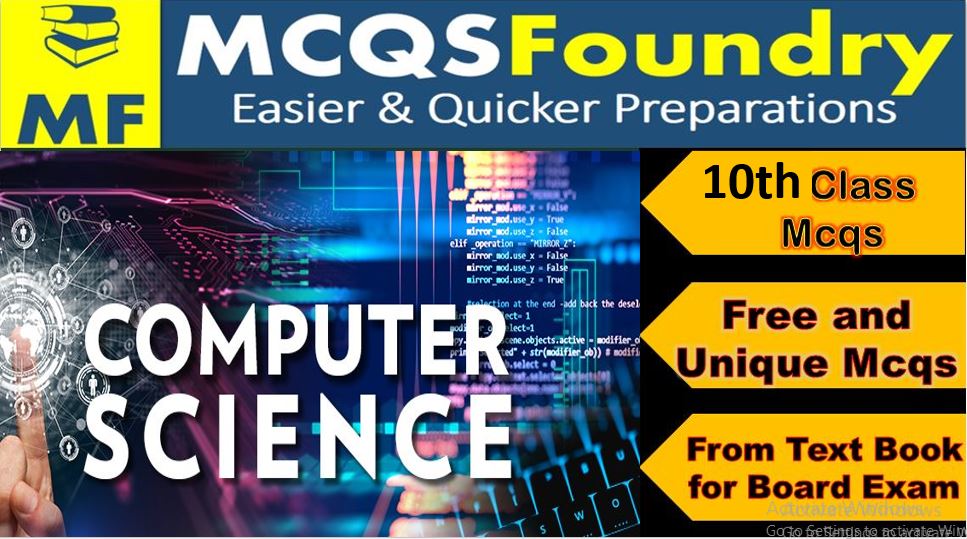MCQsFoundry.com brings to you 500+ 9th Class / Standard Computer Science Mcqs which are new and latest. These Mcqs are never published on internet so far. For full information about all PPSC / FPSC / CSS / PMS latest jobs visit theiteducation.com

Chapter No: 5
Number Systems
Encircle the most appropriate answer among the following options
1: The ASCII is a code.
(a) 5 bit
(b) 6 bit
(c) 7 bit
(d) 8 bit
2: The EBCDIC is a code.
(a) 5 bit
(b) 6 bit
(c) 7 bit
(d) 8 bit]
3: The collection of facts and figures is called
(a) Information
(b) Statistics
(c) Mathematics
(d) Data
4: The data after processing is called
(a) Information
(b) Processed
(c) Percentage
(d) Information
5: The set of characters including 26 characters of English alphabets and 10 decimal digits is called
(a) Numeric data
(b) Alphabet data
(c) Alphanumeric
(d) A11
6: Computers directly understand digits
(a) Decimal
(b) Binary
(c) Octal
(d) Hexadecimal
7: Computer did not directly understand
(a) Letters
(b) Decimal
(c) Both a & b
(d) None
8: 45, 26, 15, 40 is a
(a) Arranged data
(b) Mechanical
(c) Raw
(d) Fixed
9: Data is classified into typed
(a) 2
(b) 3
(c) 4
(d) None
10: Binary numbers are
(a) 1,3
(b) 0,10
(c) 0, 1
(d) 1,1
11: Real data contains numbers, which may be
(a) Fractions
(b) Whole Numbers
(c) Both a & b
(d) None
12: The base of decimal number system is
(a) 2
(b) 8
(c) 10
(d) 16
13: The data is represented on a computer by means of a two state ON and OFF system called
(a) A word
(b) Binary system
(c) Octal system
(d) ROM
14: The base of binary number system is
(a) 2
(b) 8
(c) 10
(d) 16
15: The base of octal number system is
(a) 2
(b) 8
(c) 10
(d) 16
16: The binary number system is used in
(a) Analog computers
(b) Binary computers
(c) Decimal computers
(d) Digital computers
17: The base of hexadecimal number system is
(a) 2
(b) 8
(c) 10
(d) 16
18: Alphanumeric characters are expressed in terms of binary codes. In ASCII each character is represented as a
(a) 8 bit code
(b) 4 bit code
(c) 2 bit code
(d) 7 bit
19: 2’s complement of 1011.1 is
(a) 0. 100. 10
(b) 0100.1
(c) 1011.10
(d) 0100.0
20: I’s complement of 1011.1 is
(a) 0. 100.101
(b) 0100.11
(c) 1011.10
(d) 0100.0
21: A byte consist of nibbles
(a) 1
(b) 2
(c) 3
(d) 4
22: 10° =
(a) 10
(b) 0
(c) 1
(d) 101
23: The digit from 0 to 9 are called
(a) Decimal
(b) Octal
(c) Binary
(d) Hexa
24: The binary equivalent of ( 20)10 is
(a) 1111
(b) 10011
(c) 10010
(d) 10100
25: The decimal equivalent of ( 20)10 is
(a) 18
(b) 24
(c) 20
(d) invalid
26: Decimal number system consists of
(a) 0,1,2,3,4,5
(b) 0,1,2,3,4,5,6
(c) 0,1,2,3,4,5,6,7,
(d) 0,1,2,3,4,5,6,7,8,9
27: 453 =
(a) 4 x 102 + 5 x 10 + 3
(b) 10 x 42 + 5 x 10
(c) 4 x 102+ 5 x 10 1 + 3 x 100
(d) None
28: The decimal equivalent of (10)s is
(a) 9
(b) 10
(c) 11
(d) 8
29: (236)10 = (?) 10
(a) 158
(b) 157
(c) 155
(d) 236
30: (A)16 =?
(a) 10
(b) 11
(c) 16
(d) 12
31: In 645 the most significant digit is
(a) 4
(b) 5
(c) 6
(d) 45
32: In 724 the least significant digit is
(a) 7
(b) 4
(c) 2
(d) 72
33: The number system that contains the range of 10 number and 6 alphabets is
(a) Decimal
(b) Octal
(c) Binary
(d) Hexa
34: (0001)2 = (?)
(a) A
(b) 10
(c) 1
(d) 7
35: Binary digits are denoted by
(a) IBT
(b) TBI
(c) BIT
(d) BTI
36: 01001(2) in decimal system is equal to
(a) 10
(b) 15
(c) 18
(d) 9
37: I’s complement of 01110 is
(a) 00011
(b) 10001
(c) 11001
(d) 01010
38: In binary number system 0 + 0 =?
(a) 1
(b) 0
(c) 00
(d) 10
39: In binary number system 1 X 0 =?
(a) 1
(b) 0
(c) 10
(d) 01
40: ASCII for 6 is equal to
(a) 0110001
(b) 0110110
(c) 1101100
(d) 0011010
41: Which of the following is not a real number?
(a) 76.2
(b) 6.2
(c) 4
(d) 4.0
42: In Hexadecimal number system the value of E is
(a) 15
(b) 12
(c) 14
(d) 16
43: The value of hexadecimal digit A is (a) 9
(b) 10
(c) 11
(d) 12
44: The number 822 represent the
(a) Binary number
(b) Octal Number
(c) Decimal
(d) None
45: Add 01011101 and 00110010
(a) 100111
(b) 1010101
(c) 10001111
(d) 100011111
46: The binary equivalent of decimal number (3)10 is
(a) 10
(b) 11
(c) 111
(d) 101
47: The binary equivalent of (F)16 is
(a) 1010
(b) 1110
(c) 0111
(d) 1111
48: The hexadecimal equivalent of binary number (101001)2 is
(a) 2A
(b) 2B
(c) 29
(d) 28
49: The most commonly used character for transmission are
(a) EBCDIC
(b) BCD
(c) UNI
(d) ASCII
50: In scientific notation power of 10 is called
(a) Logarithm
(b) Exponent
(c) Mantissa
(d) Coefficient